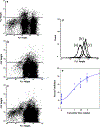Pharmacokinetic and pharmacodynamic study of tariquidar (XR9576), a P-glycoprotein inhibitor, in combination with doxorubicin, vinorelbine, or docetaxel in children and adolescents with refractory solid tumors
- PMID: 26486517
- PMCID: PMC7751951
- DOI: 10.1007/s00280-015-2845-1
Pharmacokinetic and pharmacodynamic study of tariquidar (XR9576), a P-glycoprotein inhibitor, in combination with doxorubicin, vinorelbine, or docetaxel in children and adolescents with refractory solid tumors
Abstract
Purpose: P-glycoprotein (Pgp), an ATP-dependent transport protein, confers multidrug resistance in cancer cells. Tariquidar binds and inhibits Pgp. To assess the toxicity, pharmacokinetics (PK), and pharmacodynamics of tariquidar, we conducted a phase I trial of tariquidar in combination with doxorubicin, docetaxel, or vinorelbine in children and adolescents with recurrent or refractory solid tumors.
Methods: Patients less than 19 years of age with refractory or recurrent solid tumors were eligible. Tariquidar (1, 1.5, or 2 mg/kg) was administered alone and in combination with doxorubicin, docetaxel, or vinorelbine. PK of tariquidar and cytotoxic drugs was performed. Pgp function was assessed by a rhodamine efflux assay and (99m)Tc-sestamibi scintigraphy. Tumor Pgp expression was assessed by immunohistochemistry. Response was assessed using Response Evaluation Criteria in Solid Tumors.
Results: Twenty-nine subjects were enrolled. No tariquidar-related dose-limiting toxicity (DLT) was observed. DLT related to cytotoxic drugs occurred in 12 % of subjects receiving tariquidar 2 mg/kg. When administered in combination with tariquidar, the clearance of docetaxel and vinorelbine was reduced compared to prior studies. Inhibition of rhodamine efflux was dose dependent. After tariquidar administration, (99m)Tc-sestamibi accumulation in tumor increased by 22 %. Objective responses (1 complete, 2 partial) were observed. There was no association between tumor Pgp expression and response.
Conclusion: A tolerable and biologically active dose of tariquidar was established in children and adolescents. This trial demonstrates that modulators of resistance can be evaluated in combination with chemotherapy, and pharmacokinetic and pharmacodynamic endpoints can be useful in determination of recommended dose in children and adolescents.
Trial registration: ClinicalTrials.gov NCT00011414.
Keywords: Multidrug resistance; P-glycoprotein; Pediatric cancer; Pharmacokinetics; Phase I.
Conflict of interest statement
Compliance with ethical standards
Figures



Comment in
-
Understanding the role of tariquidar, a potent Pgp inhibitor, in combination trials with cytotoxic drugs: What is missing?Cancer Chemother Pharmacol. 2016 Nov;78(5):1097-1098. doi: 10.1007/s00280-016-3044-4. Epub 2016 May 13. Cancer Chemother Pharmacol. 2016. PMID: 27178178 No abstract available.
References
-
- Agrawal M, Abraham J, Balis FM, Edgerly M, Stein WD, Bates S, Fojo T, Chen CC (2003) Increased 99mTc-sestamibi accumulation in normal liver and drug-resistant tumors after the administration of the glycoprotein inhibitor, XR9576. Clin Cancer Res 9:650–656 - PubMed
-
- Arceci RJ (1993) Clinical significance of P-glycoprotein in multidrug resistance malignancies. Blood 81:2215–2222 - PubMed
-
- Arceci RJ (2000) Can multidrug resistance mechanisms be modified? Br J Haematol 110:285–291 - PubMed
Publication types
MeSH terms
Substances
Associated data
Grants and funding
LinkOut - more resources
Full Text Sources
Other Literature Sources
Medical
Miscellaneous

